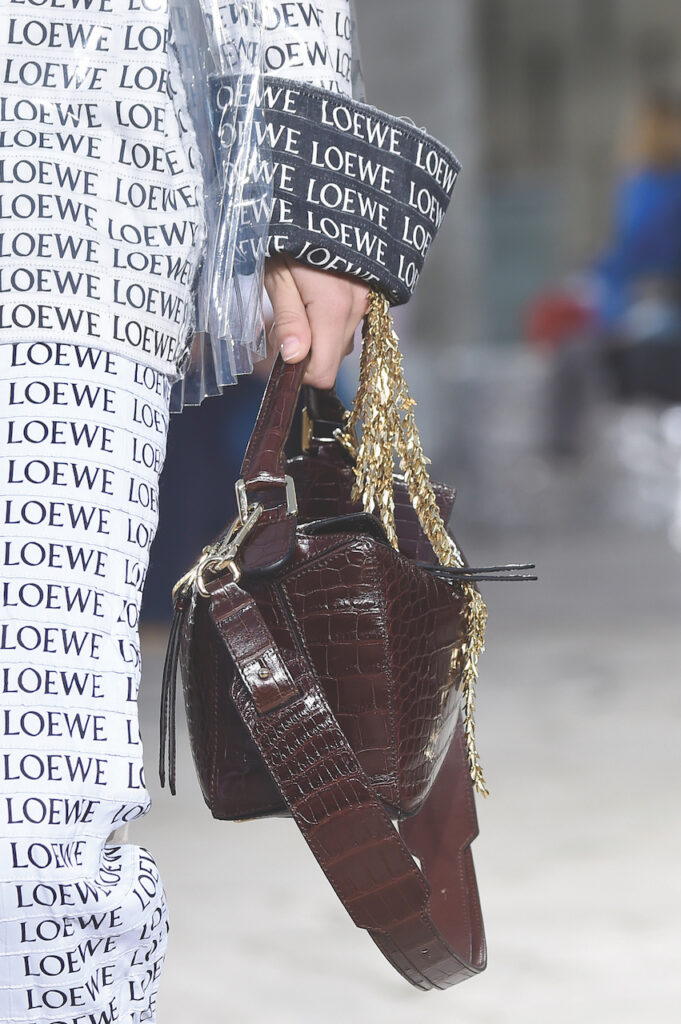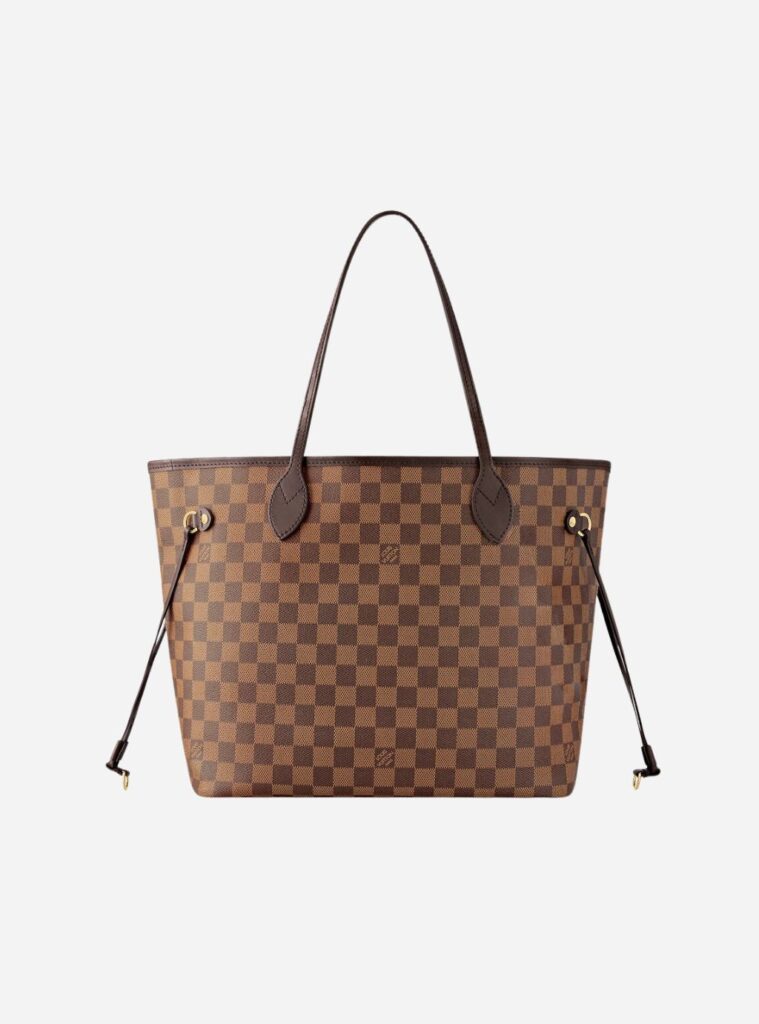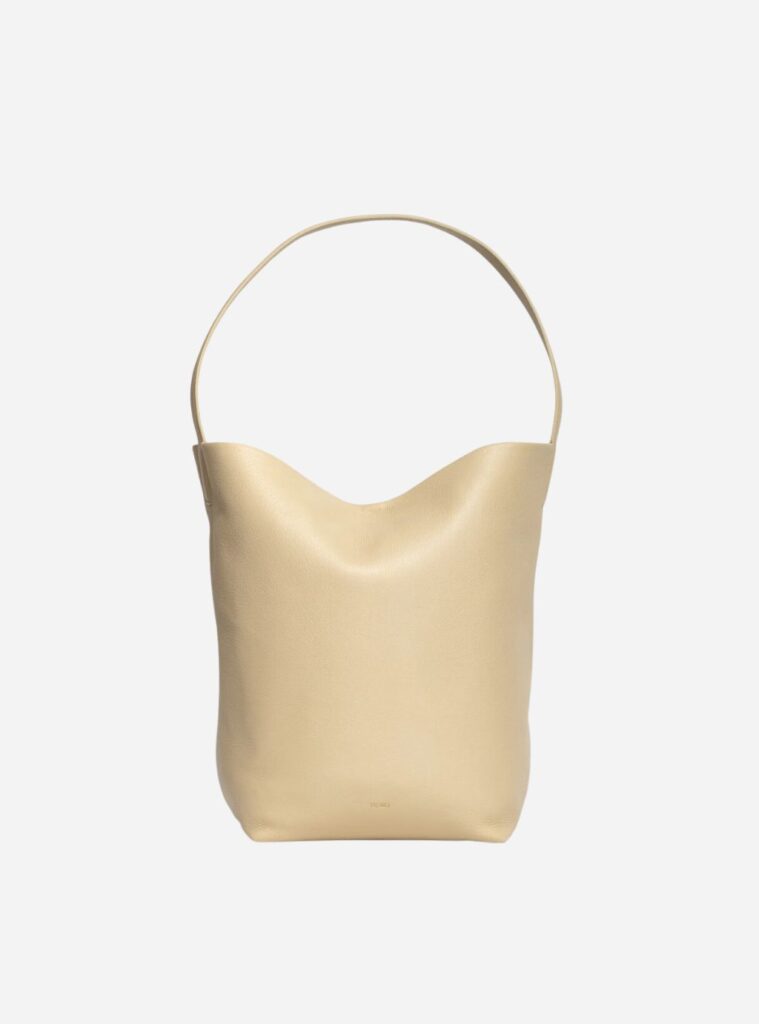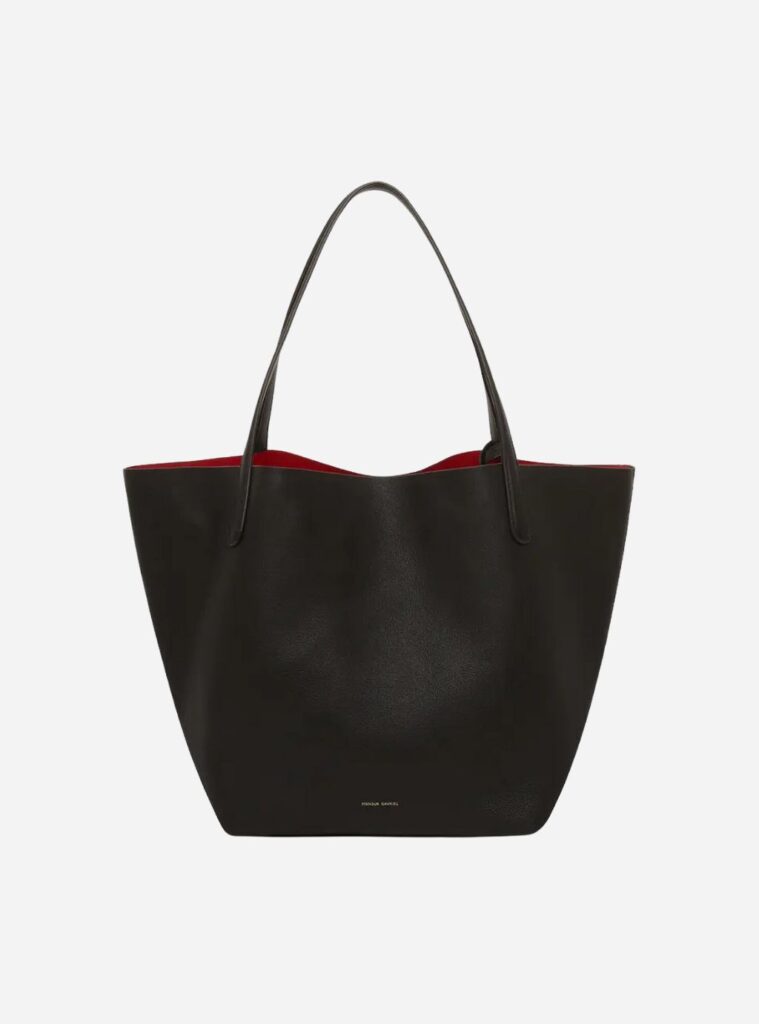Ostentatious symbols of wealth were far less frequently observed on the recent runways. Is it becoming a no-no to wear your money on your sleeve?

Attendees at the Versace Fall 2023 show held in Los Angeles earlier this year were hard-pressed to spot a Medusa head; the Italian house’s famous logo featured only subtly on buttons and earrings. The clean lines of the rooftop of West Hollywood’s Pacific Design Center in West Hollywood provided the backdrop for a collection that echoed the building’s minimalist form. Instead of Versace’s typical more-is-more offering, celebrity guests (including Elton John, Dua Lipa and Cher) saw sharply tailored suits, streamlined dresses, denim and eveningwear that was glamorous yet restrained.
Although sculptural, even the sweeping, floor-length gowns featured a painterly polka-dot print that felt surprisingly demure when styled with satin gloves that hit just below the elbow. “I wanted to go back to the cut and shape of the clothes, to concentrate on the perfect little black dress, the perfect black suit,” said Donatella Versace of her offering — a stark contrast to what we’ve previously seen from the fashion house. Rewind to Pre-Fall 2022, for which Versace collaborated with Fendi’s Kim Jones and Silvia Venturini Fendi, each swapping sides to design 25 looks for a show dubbed Fendi by Versace in a sartorial game of musical chairs that resulted in an explosion of logomania. Varying iterations of logos featured on every one of the 50 looks, in all-over prints, chunky necklaces, shoulder straps, belt buckles, jacket trim, lace, diamantés and more. It was fashion that’s unapologetically flashy, not to mention instantly recognisable.
The ‘logomania’ trend first gained traction in the Spring 2016 collections, with brands such as Louis Vuitton, Loewe, Lanvin and Gucci making their logos work overtime. Around this time, it was Gucci’s then creative director Alessandro Michele’s distinct brand of kaleidoscope romanticism that set the tone for fashion’s now-minimalist mood. Today, although logomania still lingers, recent versions are much more subtle. Case in point is the head-to-toe monogrammed Valentino look Zendaya wore to attend the label’s show in Paris late last year. The actor’s bodysuit, blazer and shorts
were covered in twinkly Vs, yet somehow seemed low-key.
Echoing Versace’s focus on cut and shape, the general mood of the Fall 2023 international runway circuit was one of restraint. Collections predominantly featured black, grey and more grey, silhouettes were dialled down to their essence, and the glitzy looks of yesteryear were nowhere to be seen.

The Miu Miu Fall 2023 collection felt distinctly tamer than seasons past, thanks to sensible silhouettes and a utilitarian palette consisting of khaki, olive and, you guessed it, grey. Just a year earlier, for Fall 2022, model Adut Akech sported a latticework diamanté two-piece layered over a powder-blue bra and bloomers, complete with satin ballet flats that became ‘It’ shoes, “the shoes to be seen in this autumn” according to British Vogue. It’s hard to imagine an item from the Fall 2023 show taking on such popularity, cult status having been rejected in favour of an anonymity of sorts. “A little serious,” was how Miuccia Prada described her show to Vogue Runway reporter Anders Christian Madsen. “I like to embrace that in this moment. Maybe I’m too careful about what’s happening around us, but I can’t leave fashion like some place of nonsense. There’s some excitement and sexiness there, but basically, I think we have to dress for thinking and for starting fresh.”
As the cost of living and interest rates continue to rise, so too does the likelihood of a recession. Perhaps that’s what she meant by “serious”. Historically, with a recession comes a wave of minimalist fashion — during the Great Depression in the 1930s, the ritzy flapper dresses of the ’20s were swapped for two-piece suits with lengthened skirts. In the 1990s, clean tailoring and gritty ‘heroin chic’ replaced the razzle-dazzle and shoulder pads of the ’80s economic boom. The crash of 2008 made way for ‘normcore’ and ‘indie sleaze’. In April of this year, the headline of an i-D article by Megan O’Sullivan on the Fall 2023 season read: “The Return of Normie Fashion Marks a Cultural Reset”.
It’s a common belief that fashion is a sign of the times, so why, in a climate of looming hardship, are phrases like ‘stealth wealth’ and ‘quiet luxury’ entering the cultural lexicon, stirring up debates around privilege one cashmere sweater at a time? Flashing your cash when people in the world are struggling could be seen as poor taste, but it’s hard to imagine the real-life equivalents of the Succession’s billionaire Roy siblings worrying about anyone but themselves. “She’s brought a ludicrously capacious bag,” said actor Matthew Macfadyen as the show’s Tom Wambsgans, critiquing a woman who had misread the room and brought the accessory to a birthday party at which the unspoken dress code was presumably ‘stealth wealth’. “What’s even in there? Flat shoes for the subway? Her lunch pail? Greg, it’s monstrous. It’s gargantuan. You can take it camping. You can slide it across the floor after a bank job.”
The scene went viral, spurring countless memes and TikToks. Around the same time, Gwyneth Paltrow made headlines for the understated outfits she wore to court during her Utah skiing-accident trial. (The price tags were not so understated, including that of the unassuming cashmere sweater by Italian label Loro Piana that retails for around $2585.) “There’s always been something chic about dressing classic and understated; while the [term] might be a fad, it’s always been around,” says New York-based Kiwi stylist Madeleine Hocquard Jones of the ‘quiet luxury’ trend. “You could always buy a white Prada T-shirt for $500. I don’t know how big quiet luxury could ever become when it appears to be exclusive to the wealthiest 3% of the world. It’s hardly aspirational to save all your coins to spend $2000 on a grey cashmere sweater. The idea of being so wealthy that you’ve ascended above the need to display it isn’t new, but it’s more out of touch as a fashion concept today than ever.”
Shop these ‘ludicrously-capacious’ bags:
In Aotearoa, an IRD investigation released in April reported that “the data, based on full income information from 311 of our wealthiest citizens, shows that the average person in this group pays an effective tax rate of just 8.9% on their economic income — that is, income from all sources, including capital gains on investments”. In comparison, someone on a salary of $80,000 with no other income would pay more than double that amount of tax. Combine this with the increasing cost of living, and ‘quiet luxury’ and ‘stealth wealth’ feel redundant, concepts reserved for TV screens and the court appearances of the rich and famous.
Meanwhile, the luxury resale market is on the rise, providing broader access to luxury goods while also being a barometer of where longevity truly lies when it comes to design. Head of fine jewels, watches and luxury accessories at Webb’s auction house, Christine Power, identifies some key styles in the leathergoods arena. “Quota bags by Hermès are highly sought after as they’re rare and difficult to acquire. We’re seeing a perpetual increase in interest across the New Zealand secondary market
for [Hermès] ‘Birkin’, ‘Kelly’ and ‘Constance’ bags as purchasing them new often requires a lengthy wait. “We’re also seeing a major uptake in structured bags by Louis Vuitton, including the ‘Pochette Accessories’, the ‘Alma’ and tote styles,” she continues. “Classics from Louis Vuitton continue to hold steady as many people are gearing up to travel. The timeless look of monogrammed ‘Keepall’ and epi-leather options are popular as they’re durable, high-quality and designed to last a lifetime. Caviar-leather flap bags from Chanel are also trending as they’re quality pieces with low supply and high demand.”
Maybe Tom Wambsgans was wrong after all. Madeleine Hocquard Jones also sources and collects vintage Chanel, selling a selection of pieces via Instagram account @order_no5. “Chanel is so much more than the clothes — it’s a story,” she says of the label’s unwavering appeal. “It has such a deep heritage and long legacy of being luxurious, meticulous, versatile and glamorous. Its designs endure through every generation, in part because icons of every generation have worn it, from pop stars to royalty. This gives Chanel that great sense of timeless transcendence. It’s never a fad, it’s Chanel, and when you buy Chanel from any era, you’re buying into a legacy we all want to be a part of.”
Maybe, rather than getting caught up in a flurry of buzzwords and micro-trends, luxury is best viewed through a lens of longevity. Whether plastered in logos or discreetly tailored, the true value comes in knowing that a piece will stand the test of time, enduring not only in terms of quality but also one’s ever-changing tastes and whims.



